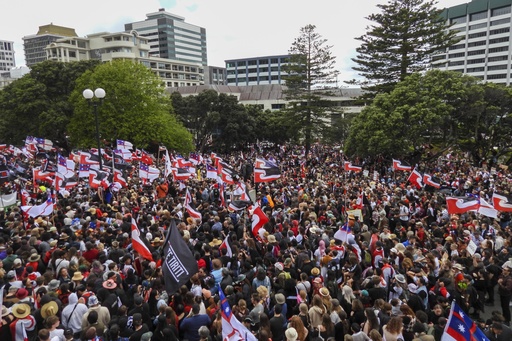
WELLINGTON, New Zealand — On Tuesday, the streets of Wellington were filled with tens of thousands of marchers waving flags, creating an atmosphere reminiscent of a celebratory festival or parade rather than a traditional protest. The gathering was prompted by concerns over proposed legislation aimed at altering the foundational treaty between the Indigenous M?ori and the British Crown. However, for many participants, the event represented more than just legislative opposition; it was a vibrant celebration of the revitalization of Indigenous language and culture, which colonialism had nearly obliterated.
“Just fighting for the rights that our t?puna, our ancestors, fought for,” expressed Shanell Bob, who was eagerly awaiting the march’s commencement. “We’re fighting for our tamariki, for our mokopuna, so they can have what we haven’t been able to have,” she added, using M?ori terms for children and grandchildren.
This event is set to be one of the largest demonstrations for M?ori rights to take place in New Zealand. The movement aligns with a history of peaceful marches across the nation that have marked significant shifts in the socio-political landscape of modern New Zealand.
One of the organizers excitedly declared from the stage, “We’re going for a walk!”, while attendees congregated at the opposite end of the city from Parliament. Some had even traveled across the country for nine consecutive days to be part of this remarkable outpouring of support.
The impressive turnout also illustrated an increase in solidarity among the non-M?ori population regarding Indigenous rights. During the typical morning commute, individuals of various ages and ethnicities gathered at bus stops, carrying M?ori sovereignty flags. Many local schools opted not to record students as absent for participating in the event, and the city’s mayor even joined in the protest.
Although the proposed bill that prompted the march faces significant unpopularity and an uncertain future, the rising discontent among citizens signals an emerging awareness of the promises outlined in the Treaty of Waitangi, alongside a vocal pushback from those angered by perceived constraints imposed by legislative and judicial decisions.
While advocating for rights as established in the treaty is not a novel occurrence for M?ori, the sheer size of the crowd and the prevailing sentiment were distinctly different this time, according to some participants.
“It’s different to when I was a child,” Bob remarked, noting the evolution of the movement. “We’re stronger now, our tamariki are stronger now, they know who they are, they’re proud of who they are.”
As the marchers wound their way through Wellington, they filled the air with traditional M?ori haka and waiata. Along the route, a multitude of supporters lined the sidewalks holding signs.
Some signs carried humorous quips or derogatory comments aimed at the lawmakers accountable for the bill, which seeks to redefine the principles of the 1840 Treaty of Waitangi, limiting its implications to M?ori—the chiefs had originally signed the document during the era of colonization. Conversely, other placards proudly declared “Proud to be M?ori” or acknowledged the signatories’ non-M?ori heritage while endorsing the protest. Several signs criticized the extensive confiscation of M?ori land throughout colonial history, which remains a significant grievance associated with the treaty.
“The treaty is a document that lets us be here in Aotearoa, so holding it up and respecting it is really important,” stated Ben Ogilvie, a member of the P?keh? community, using the M?ori name for the country. “I hate what this government is doing to tear it down.”
According to authorities, more than 35,000 individuals filled the grounds surrounding Parliament, with even more spilling into adjacent streets. Attendees seeking a better view climbed onto a children’s slide in the lawn area, while others found vantage points in nearby trees. The atmosphere was predominately joyful, as some participants began singing traditional M?ori songs that many New Zealanders learn during their schooling.
A sea of M?ori sovereignty flags, styled in red, black, and white, waved proudly along the lawn and into the streets. Additionally, flags from Samoa, Tonga, Indigenous Australia, the U.S., as well as Palestinian and Israeli flags, were also displayed. At the Parliament, speeches from political leaders underscored the rationale behind the protest—against the proposed law that would redefine key phrases in the nation’s founding treaty and extend their implications to the entire population.
The bill’s proponent, libertarian politician David Seymour—who also identifies as M?ori—argues that the compensatory measures for historical breaches of the treaty by the Crown have led to preferential treatment for Indigenous peoples, a stance he opposes. Opponents of the bill argue it could lead to constitutional upheaval and dilute Indigenous rights, citing that M?ori continue to experience significant disadvantages across various social and economic metrics, even amid recent efforts by courts and lawmakers to mitigate disparities influenced by treaty violations.
While the bill is not anticipated to pass, Seymour has brokered a political compromise allowing it to advance to a preliminary vote last Thursday. In a statement issued on Tuesday, he invited public commentary on the proposed legislation, hoping to see a resurgence in support.
Seymour briefly emerged onto the forecourt of Parliament to witness the protest but did not participate in the speakers’ lineup, drawing boos from some in the crowd.
“This protest was a long time coming,” remarked Papa Heta, a marcher emphasizing the demand for acknowledgment and respect from the M?ori community. “We hope that we can unite with our P?keh? friends, Europeans. Unfortunately, there are those that make decisions that put us in a difficult place.”
